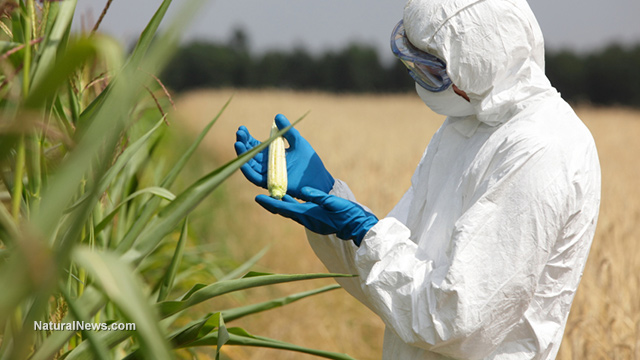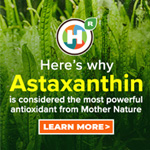New multi-toxin GMOs that produce their own poison carry 'serious health and environmental risks' scientific review finds
Thursday, December 17, 2015 by: David Gutierrez, staff writer
Tags: Stacked trait crops, Bt crops, GMOs

(NaturalNews) New strains of GM crops that produce pesticides in their own tissues are being approved without rigorous safety testing, even though they may carry "serious health and environmental risks," according to a research review conducted by scientists from the Swiss Federal Institute of Technology and the German Federal Agency for Nature Conservation, and published in the journal Frontiers in Environmental Science on November 9.
The crops in question are engineered to carry pesticide-producing genes from the bacterial species Bacillus thuringiensis (Bt). In recent years, companies have increasingly turned to crossbreeding different varieties of Bt crops, producing crops that now carry numerous different strains of Bt toxin at once. These "stacked-trait" crops are being approved for planting and sale, based on several false assertions made by the genetically modified (GM) crop industry, the study found.
Hiding toxic effects
One such assertion is that each individual Bt toxin affects only a small number of insect pests, and has no effects on other species such as beneficial insect predators ("non-target" species). But the researchers found numerous studies showing the opposite to be true.According to lead researcher Angelika Hilbeck, companies hide the truth by defining non-target effects in a highly narrow fashion: a "quick kill."
"This is an economic concept: you want a quick kill for economic reasons, to save the crop from pest-induced damage," Hilbeck said. "But Bt toxins are not fast-acting toxins. Even in target pests, Bt toxins don't kill quickly – it takes most susceptible insects a day or more to die. The Bt toxin in GM crops is expressed in the crop plant for months at a time. Residues linger in soil and aquatic systems.
"Regulatory tests need to look at long-term and sublethal effects, because that is what non-target organisms are likely to be exposed to. Currently these tests are not required. Yet we found a lot of evidence in the scientific literature that non-target organisms such as ladybirds, water fleas, lacewings and even slugs are adversely affected by Bt toxins."
The review also turned up evidence that Bt toxins may have long-term, toxic effects in mammals – including, potentially, in humans who eat GM crops.
The uncertainty around the safety of stacked-trait Bt crops is only worsened, the researchers noted, by the fact that scientists do not even understand how Bt toxins function. The formerly accepted model has been widely discredited due to new research, and the revelation of scientific misconduct and data tampering by the researchers who first proposed it.
More dangerous than single pesticides
Another false industry claim is that use of Bt crops reduces pesticide use. But the review found that the total pesticide load in stacked-trait Bt crops often exceeded the typical amount of pesticide used in a non-GM field. For example, SmartStax GM corn contains six different Bt toxins and two herbicide tolerant traits. The total Bt toxin load in this crop is 19 times the average 2010 pesticide application rate!Perhaps the most glaring regulatory failing uncovered by the review, is the acceptance of industry claims that stacked-trait crops should be approved on the basis of tests conducted on single-trait crops. Yet the review uncovered numerous studies showing that stacked-trait crops caused biological effects not produced by any of the individual toxins alone. The same thing occurred when Bt toxins were mixed with neonicotinoid insecticides, as commonly occurs in the field.
The review also found that industry dossiers seeking stacked-trait approval consistently failed to mention the studies that contradicted their false assumptions. Regulators did not require any further safety testing of stacked-trait crops, beyond a few short-term insect feeding trials.
Instead, the researchers said, regulators should require long-term mammal feeding trials, as a minimum.
Furthermore, Hilbeck said, "We have to extend the definition of 'effect' from the economic to the ecological."
Sources for this article include:
GMWatch.org
Stacked trait crops at FETCH.news
Get independent news alerts on natural cures, food lab tests, cannabis medicine, science, robotics, drones, privacy and more.
Take Action: Support Natural News by linking to this article from your website
Permalink to this article:
Embed article link: (copy HTML code below):
Reprinting this article:
Non-commercial use OK, cite NaturalNews.com with clickable link.
Follow Natural News on Facebook, Twitter, Google Plus, and Pinterest
- European Court of Justice: Healthcare professionals who promoted or administered COVID-19 vaccines are CRIMINALLY LIABLE for any harm caused
- Newly released JFK files reveal Pentagon's role in creating Lyme disease and covid in the same lab
- Oncologist warns of ‘terrifyingly aggressive’ cancers in children, linked to immune suppression from COVID vaccines
- Britain’s descent into police state censorship: Parents raided for questioning their daughter’s school system online
- Ancient kitchen secrets REVEALED: How garlic, ginger and green onions fight cancer and heart disease
- DARPA: The shadowy innovator behind the world’s most advanced military technologies
- NIH study, buried for decades, reveals that Flu Shots INCREASE elderly deaths, not prevent them
- COVID-19 scandal linked to CANCER SURGE: Billionaire researcher sounds alarm
- “Old Man in a Chair”: The COVID-19 pandemic was a carefully orchestrated scheme for global control
- Decentralize TV: Dr. Leonard Coldwell reveals shocking, heavily censored truths about CANCER, healing and the medical mafia complex
- Cinnamon plays a critical role in diabetes management
- Musk targets “strangely wealthy” lawmakers in DOGE probe, names Pelosi, McConnell, Schumer
- Utah governor allows ban on LGBT pride flags in public buildings and schools, will take effect without his signature
- RFK Jr. is reforming Americans’ health: A shift in power and paradigm
- FRAUD ALERT: Details DEMOCRATS do NOT want you to know about the $40 BILLION wasted on Fed-loaded credit cards cancelled by DOGE
- Scientists unveil breakthrough method to eliminate "Forever Chemicals" from water, transforming waste into graphene
- Postcard from 1875 highlights smallpox vaccine’s failure: Lessons for today’s COVID-19 response
- Massive egg substitution recall: Bleach contamination sparks nationwide concern
- Newly released JFK files reveal Pentagon's role in creating Lyme disease and covid in the same lab
- CDC finally halts $11 billion COVID funding scam as health officials admit the ‘pandemic’ was a fraud
- Analysis: The coming economic collapse, a mass uprising and Trump's three secret weapons to halt the growing revolt
- Kiss Your Genetic Privacy Good-Bye! 23andMe Gets Green Light to Sell Your Intimate Genetic Details to Anyone They Want
- Dr. Suzanne Humphries makes bombshell appearance on Joe Rogan podcast, exposing vaccine industry deception back to POLIOMYELITIS
- DEADLY DECEPTION: How COVID vaccines increased mortality rates and why authorities hid the truth
- Woman contracts WORLD'S DEADLIEST VIRUS after unknowingly being given the WRONG VACCINE
- Oncologist warns of ‘terrifyingly aggressive’ cancers in children, linked to immune suppression from COVID vaccines
- Here are TEN all-natural ways to protect your garden without using harmful chemicals
- Black cumin seed oil emerges as a powerful ally against breast cancer and chronic inflammation
- The hidden dangers in your kitchen: How cooking methods impact diabetes, cancer and aging
- Trump's greatest betrayal so far: Accelerating Middle East wars, silencing dissent, and serving Zionist masters
- Senate Democrats deny censorship industrial complex existed, defend government's role in silencing dissent
- Sugar-free deception: Artificial sweeteners hijack hunger signals, fuel obesity epidemic, study warns
- “Independent” anti-Russia outlet MEDUZA faces COLLAPSE as US funding dries up
- NIH study, buried for decades, reveals that Flu Shots INCREASE elderly deaths, not prevent them
- The Health Ranger releases “Vaccine Zombie” song and music video, using AI-animated zombies for the music video
- Discovery of vast underground city beneath Giza pyramids challenges human history
- Newly released JFK files reveal Pentagon's role in creating Lyme disease and covid in the same lab
- California's social media censorship law struck down: A victory for free speech or a threat to online safety?
- EPA advisor admits the agency is funneling billions to climate groups ahead of Trump’s return to White House
- The Health Ranger releases “Vaccine Zombie” song and music video, using AI-animated zombies for the music video
- Dr. Mike Yeadon releases 15-minute testimony - WATCH - about genocidal intent of COVID “vaccines”
- Florida takes a stand: DeSantis proposes permanent ban on mRNA vaccine mandates
- Mike Adams releases country western hit single: Goin’ Back in Time is Comin’ Home
- “Why we influenced the 2020 elections”: Facebook files reveal the coordinated effort to bury the Hunter Biden laptop story
- Unpacking the Lies That We’ve Been Fed – new song and music video released by Mike Adams, the Health Ranger
- House Intelligence Committee calls for the ARREST and PROSECUTION of Dr. Anthony Fauci
- The pandemic as a tool for INDOCTRINATION: Understanding “The Indoctrinated Brain” by Dr. Michael Nehls
- Rep. Nancy Mace introduces bill to ban biological males from female facilities on federal property
- Mike Adams releases music poetry sensation: A Child of God
- Sugarcane extract superior to cholesterol-lowering drugs?
- Survival 101: Effective EMF blocking techniques
- Michigan sheriff announces criminal investigation into 2020 election crimes, Dominion Voting Systems
- Peter Rost exposes Big Pharma corruption in his book “The Whistleblower: Confessions of a Healthcare Hitman”
- Migrants are taking advantage of recent hurricanes to scam residents and loot their homes
- Red Cross issues warning to stop blood plasma donations from vaccinated people
- Scientists confirm: GENIUS brain function can be spontaneously unleashed in humans without any apparent cause
- EPA advisor admits the agency is funneling billions to climate groups ahead of Trump’s return to White House
- HYSSOP: What research reveals about the health benefits of this ancient holy herb
- Two containers with completed ballots fall out of truck in Florida
- Fully vaccinated about to see “tsunami” of illness and death, warns virologist
- Global leaders unite to clamp down on “misinformation” with UN-backed Cascais Declaration
- BREAKING: 2025 NDAA authorizes mandatory military draft of WOMEN across America… as Pentagon pursues global NUCLEAR war with both Russia and China at the same time
- Michael Yon warns of a ZIONIST TAKEOVER in Trump’s second administration
- BOMBSHELL: DNA testing kits are a SCAM to develop ethnic-specific bioweapons
- Ozempic and Wegovy weight loss drugs are injectable LIZARD VENOM PEPTIDES that may unleash a devastating wave of organ failure… side effects align with symptoms of SNAKE BITES
- Israeli soldiers accused of even more torture and abuse in the West Bank
- These 13 countries just signed an agreement to engineer a global FAMINE by destroying food supply
- NASA admits that climate change occurs because of changes in Earth’s solar orbit, and NOT because of SUVs and fossil fuels
- RFK Jr. clears key hurdle: Sen. Susan Collins backs controversial HHS nominee, signaling a new era for health policy
- Sermon 30: How Jesus reveals Caesar’s FAKE CURRENCY and FALSE AUTHORITY
- Coriander seeds: Ancient medicine backed by modern science
- Arizona officials claim Maricopa County needs 10-13 days to tabulate results of the election
Science News & Studies
Medicine News and Information
Food News & Studies
Health News & Studies
Herbs News & Information
Pollution News & Studies
Cancer News & Studies
Climate News & Studies
Survival News & Information
Gear News & Information
News covering technology, stocks, hackers, and more



"Big Tech and mainstream media are constantly trying to silence the independent voices that dare to bring you the truth about toxic food ingredients, dangerous medications and the failed, fraudulent science of the profit-driven medical establishment.
Email is one of the best ways to make sure you stay informed, without the censorship of the tech giants (Google, Apple, Facebook, Twitter, YouTube, etc.). Stay informed and you'll even likely learn information that may help save your own life."
–The Health Ranger, Mike Adams












































